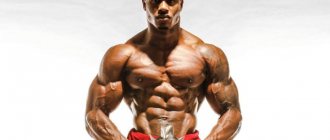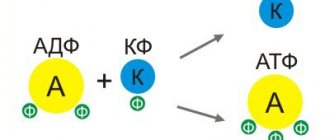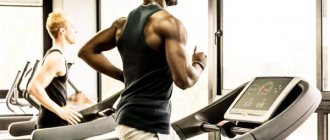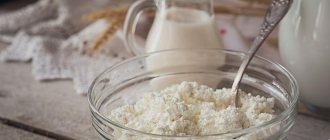What to Consider When Designing a Training Program to Gain Muscle Mass
For muscle hypertrophy, the standard protocol is to perform 8 to 12 repetitions at a good intensity, leading to failure of the last repetition. Medium-duration or short rest (30-120 s) between sets leads to a significant metabolic demand. The mechanical tension of the muscles involved in the contraction ensures that 3-4 approaches are performed in the exercise.
The pace of movement should include both a short phase of concentric contraction (no more than 1-2 s), and a relatively long phase - eccentric (2-6 s), which has a greater impact on muscle development (from the point of view of hypertrophy), since during it it is faster protein synthesis occurs.
Complex, multi-joint movements with barbells, kettlebells and dumbbells work more different muscles, so the metabolic impact they can have is significant, especially in the 12-20 rep range.
Single-joint or isolated movements provided by the simulators can direct the impact strictly to a specific muscle, i.e. load it as much as possible.
The exercise program for increasing muscle mass presented below is based on the latest scientific research. However, because the mechanical and metabolic demands of high-volume training can cause quite serious muscle damage, it is recommended for clients with at least a year of free-weight training experience.
First of all, you need a good dynamic warm-up, which should include exercises for the core muscles and a variety of movements without weights. This will prepare the muscle tissue for the stressful effects of high-volume exercise. Warm-up is performed for the whole body, even if the workout involves loading its individual parts (one or two). A full warm-up will help increase calorie expenditure and will be useful for restoring muscles that were stressed in the previous workout.
The final ones should be exercises in the simulator and an approach with weight reduction: when all repetitions of the approach are completed to failure, the weight is reduced, with which the possible number of repetitions to failure is now performed again. These approaches can cause significant stress (metabolic and mechanical), as well as cause discomfort. That is why it is recommended to perform them at the end of training.
For each person, the program must be developed individually, taking into account her/his goals. The program, as you can see, limits cardio load, since excessive energy consumption can lead to a decrease in muscle growth.
How to remove additional payment for increasing the volume of work?
To remove the additional payment, you need to remove the employee’s responsibilities for performing the assigned work. The manager needs to issue an order to stop accrual of remuneration. Based on this document, the accounting department stops payments.
IMPORTANT! The increase in the scope of work can be stopped after the deadline for its introduction has expired. For example, an employee is assigned additional responsibilities for the period from June 1 to June 20. Payments stop on June 21. The manager must draw up an order in any case.
The increase in the scope of work may be terminated early. The formalization of this depends on whose initiative the termination of the previous agreement occurred. If this is the initiative of the worker, then a statement is drawn up, if the initiative of the employer is a notification, which must be familiarized to the employee against signature. The document is sent to the interested party three days before the load is reduced. For example, if it is expected that the employee’s duties will be removed on July 23, the application must be sent on July 20.
Fanaticism is not our friend
Exercises are different from exercises.
Your goal is to sculpt your figure by building muscle mass, so you shouldn’t train like a man, spending days in the gym.
You should temporarily reduce your cardio training - no more than two runs per week for 20 minutes. Otherwise, the muscle tissue will be “burnt.”
Important!
Experts do not advise eliminating “cardio” altogether: it supports the heart and trains endurance.
What else will help?
1. The ability to relax and get good sleep. Muscles repair and grow during sleep.
2. Setting specific goals: results are easier to achieve and control.
Expert commentary
Vladimir Patshin, master trainer
If you decide to take care of your body and gain muscle mass, then you are already halfway to success, it’s time to take action. To achieve your goal, you need a clear plan and an understanding that you will need to change a lot in your life.
First, let's decide on the direction of training. Which is preferable for you:
traditional training in the gym or new technologies, such as EMS (electrical stimulation training).
In both cases, it is necessary to draw up the correct program; it is advisable to entrust this mission to a professional, i.e. a qualified trainer, and not a sports neighbor in the stairwell. You can safely check whether you have a specialized education and a supporting document. The specialist will choose exercises and appropriate nutrition that suit your body’s needs.
At the initial stage, you should not rush to all the exercise machines; accustom yourself and your body to new loads. Use basic exercises for two or more muscle groups. The compiled program can be worked out both in a regular gym and in EMS studios.
What are the differences?
In the amount of time for studying. 20 minutes of EMS training is equal to 2-3 hours in the gym. Unfortunately, precisely because of the short duration of the workout, EMS is unfairly considered fitness for the lazy, but EMS is a technology that has spread throughout the world: an electrical impulse allows you to work out deep muscles, thereby accelerating the process of achieving results.
By the way, you can safely combine both areas of training, but without fanaticism. Train no more than 3-4 times a week in the gym (depending on the training program), on an EMS simulator - no more than 2-3 times a week.
Nutrition
Without receiving the necessary building elements for muscle growth and body functioning, you will not make progress. Don’t make the main mistake of thinking that for muscle growth you need a lot of consumed kcal, all excess will be stored in fat depots! For maximum quality gain, you do not need to exceed by more than 500 calories the mark that the body spends on its vital functions. You can figure out how to build a correct and competent diet for muscle growth yourself, or contact a specialist in this field. It's up to you, again, to decide.
Rest and sleep
Without proper recovery and quality sleep, you will also not make progress. Muscle growth happens in the rest phase, not in the training room, where you just push growth, shock the muscles and force them to become stronger and fuller. Allow at least 7-8 hours for sleep and eat regularly.
Only by adhering to these three basic rules in combination will you be able to achieve your goal!
Women can build muscle while maintaining the basic elements of strength training, so don't train to the point of exhaustion like a champion powerlifter.
Skeletal muscles
The tissue of the main and auxiliary muscle groups consists of muscle fibers and water. Moreover, the liquid level is approximately 75%. The fibers contain two types of cells: myosymplast and satellites. The fibers come in different lengths and can reach several cm, for example, as in the sartorius muscle. Tissues are attached to the skeleton or to each other using tendons. There is a special table with a brief description of all the main skeletal muscle groups. Let's look at the basic information from it.
- Head. Chewable, mimic. They move the lower jaw, help in expressing emotions, speech, and breathing.
- Neck. Consists of 14 muscles. They support the thyroid gland, protect it when swallowing, bring dynamics to the head, and are responsible for turns and rotational movements of the cervical spine.
- Back. Shoulder, lumbar and pelvic regions. Muscle fibers are involved in the arch, rotation of the upper limbs, support the body and spine in a straight position, and protect the spine.
- Breast. Shoulder and chest sections. Muscle fibers are involved in breathing, protect the chest and the organs located in its cavity (lungs, heart), and are activated by the movement of the arms and neck.
- Stomach. Diaphragm, abs, oblique muscles. Muscles are also included in the table of main groups; they hold and protect the abdominal organs, and are involved in turning the body, twisting, and inhaling and exhaling.
- Hands. Forearm, shoulder, wrist, phalanges. Muscle fibers provide arm movements.
- Legs. Thigh, lower leg, foot. Any dynamics of the lower extremities, as well as balance during the movement of the torso, are provided precisely by the muscles.
The main human muscle groups are also divided into superficial and internal. After all, they are located throughout the body in several layers. Depending on the work performed, there are: flexors, extensors, rotational muscles, responsible for adduction and abduction. They also vary in shape, because they come in the form of a ring, square, triangle, etc.
Method 28
Most athletes are already familiar with the classic method of increasing biceps volume using the 21 system, which was popularized by bodybuilding legend Arnold Schwarzenegger. Almost every young athlete has used it to increase muscle mass in their biceps.
We have developed a new method - 28, which is based on method 21. The main goal of the method: creating more tension in your muscles
If you don't know, method 21 followed this principle:
1. You perform 7 partial range reps. From full extension of the arms to the point when the forearms are parallel to the floor.
2. Then 7 partial repetitions from the middle until the full range of motion is completed. Finally, you'll finish with 7 more reps using a full range of motion. For a total of 21 repetitions.
Technique for performing method 28
The exercise can be performed sitting, standing, or on a Scott bench (using either a barbell, dumbbell, or EZ bar), without resting between reps:
1. Perform 7 partial reps through a partial range of motion to mid-range of motion.
2. Perform 7 repetitions in the full range, holding in the middle of the range for 7 seconds.
3. 7 repetitions from the middle to the end of the amplitude
4. 7 repetitions in full amplitude without delay in the middle.
Using these 4 methods, you can vary your workouts, which will provide a good workout for your arm muscles. Thus, you will achieve an increase in biceps volume.
Related article: “One-arm dumbbell row”
The best exercises for arm muscles Choose your type of nutrition to achieve results faster!
Nutrition for weight gain Nutrition for weight loss
- 5
- 4
- 3
- 2
- 1
(1
voice, average: 5 out of 5)
Create your personal training program:
Workout in the gym
With exercises using block lifting and barbell presses, you will undoubtedly achieve effectiveness in achieving your goal. The block exercise machine allows you to keep your biceps under constant tension and work with heavy weights. This is the difference between a cable machine and a barbell curl. When working out a can while lifting a block, it makes no sense to strictly adhere to the execution technique; it limits the use of large weights.
Work through a full range of motion, stretching and contracting the muscle groups above and below. It is advisable not to cross the load point. In order to get the greatest impact while performing an exercise with a barbell, it must be done without strict use of technique. If you allow the body to move freely while working with a barbell, the quality of the work will increase several times, and most importantly, you will avoid possible traumatic nuances. A very strict technique interferes with the use of large weights and the naturalness of mechanics.
Of course, this does not mean uncontrolled movement of the bar; you can simply slightly deviate the body along a natural trajectory. Work strictly at full amplitude. Stretching and contraction of muscles should be maximum. Extension and flexion with a barbell are the best exercises in developing the muscles we need.
Include this task in every workout; it has a very positive effect on the muscle when returning the bar to the main position.
How to increase volume in a month?
In order to achieve the growth of your can in height, it is necessary to perform concentrated lifts. From the starting position, sitting on a bench, feet shoulder-width apart, the elbow joint of the hand with dumbbells should rest against the inner thigh, with the other hand hold the knee joint.
Inhale. The hand goes to the chin. Exhalation. Initial position. Hands must be alternated. Do not plan to start your workout with a concentrated lift. Place this exercise in the middle of your training time.
How to increase biceps width
The best exercises that will give the muscle groups of the arms relief and volume.
- Curling your arms with dumbbells or a barbell. If you want to increase the size and strength of your biceps, perform familiar exercises with weights.
The video below shows step-by-step executions of tasks to increase the volume and definition of the biceps. As you can see, the main thing for pumping is not very large weights, you need correct execution, stability, and perseverance.
training strategies to increase strength, mass and size
How do muscles grow?
In the first part of the material it was said that the number of muscle fibers is determined genetically, and muscles grow due to an increase in volume (“hypertrophy”). It is believed that more than 80% of growth is due to increased connective tissue(1).
The remaining 20% of growth is due to increased nutrient storage in the muscles. But despite the fact that this is only 20%, without providing nutrients, muscle growth is simply impossible. As always, the Pareto 80/20 rule applies.
The Role of Nutrition in Muscle Gain
In response to strength training, the body increases the amount of energy and nutrients stored in the muscles, which allows you to train longer and more effectively, as well as heal microdamages and build new connective tissue faster.
Increased nutrition after a workout (“carbohydrate window”) is important for developing the body’s ability to convert and store energy for stronger workouts the next time. If you don't eat enough, it significantly impairs muscle growth
Muscle growth and hormones
To absorb amino acids and grow, muscle cells need special enzymes; The cell's ability to produce these enzymes is very limited, but in some cases the surrounding satellite cells are able to give it this valuable enzyme.
First of all, satellite cells are activated by hormones (growth hormone, testosterone, IGF-1 and others), the production of which increases with strength training; secondly, the activity of satellite cells increases when taking creatine (2).
Strength Training
Although increasing muscle strength is directly related to increasing muscle size, performing exercises with heavy weights and low repetitions recruits a specific type of muscle fiber - maximally fast fibers (Type II).
If your goal is to increase strength, then you need to perform exercises with a weight of 85% of 1MP for 3-5 repetitions (3). Such training activates the nervous system and increases the production of hormones, which is what, for example, the basic program is based on.
Workouts to increase mass
If your main goal is to increase muscle volume, then you need 6-12 repetitions of the exercise and a working weight in the range of 70-85% of 1MP(3). Keep in mind that the smaller the muscle group, the more repetitions it requires, and vice versa.
Medium-repetition training engages medium-type fast-twitch (Type IIB) muscle fibers that respond to glycogen, which, together with increased blood circulation and sufficient nutrients in the blood, will increase muscle size.
Optimal training frequency
The duration of muscle fiber recovery after training and the accompanying growth takes 36-48 hours, so it is strictly not recommended to train the same muscle group more often. But let us note once again that without nutrition this growth is impossible.
First, carbohydrates are important before strength training to replenish glycogen stores for that workout; secondly, you need protein nutrition, calcium and vitamins for muscle growth; thirdly, creatine to improve the energy of muscle cells.
***
Performing exercises with heavy weights and low repetitions primarily increases strength, while performing exercises with medium weights and medium repetitions increases muscle mass and size. But without adequate nutrition and recovery, muscle growth will not occur.
- Muscle Growth: Why, And How, Does A Muscle Grow And Get Stronger, Casey Butt, Ph.D., source
- Creatine supplementation augments the increase in satellite cell and myonuclei number in human skeletal muscle induced by strength training, source
- Rational and Irrational Hypertrophy: Why Aren't Olympic Lifters Bigger Than Bodybuilders?, source
There is no bodybuilder who would not like to have massive, sculpted arms. Almost all IFBB champions demonstrate phenomenal arm muscle development. There are bodybuilders whose genetic potential allows them to have huge arms without spending much effort on this - for example, A. Backles. Even before competitions, he rarely does more than 10-12 sets for biceps and triceps, 2 times a week. Meanwhile, others spend much more time developing their arms and still cannot match Backles. However, any bodybuilder with a serious approach to this issue can significantly increase the volume of his arms and improve the shape of his biceps and triceps.
Adviсe
1. To fully develop your biceps, you must supinate your wrist when doing dumbbell or pulley curls. Some champion bodybuilders made a quantum leap in biceps development as soon as they began performing wrist curls. 2. All types of concentrated curls will help you develop the natural peak of your biceps. However, perform hundreds of sets of these exercises, and if your genetic biceps are flat, you will not develop a peak. Remember S. Oliva! Boyera Kou, having good genetics and including concentrated curls in his training, on the contrary, developed his biceps to failure. 3. Many bodybuilders, wanting to develop their triceps to the maximum, often injure them. What to do?
It is better to avoid injuries from the very beginning, but if your elbows are already injured, you should try not to get a “trauma injury”. The main thing is a thorough warm-up . L. Ferrigno advises starting arm training with the biceps, and then warming up the triceps with three to four “light” sets of cable rows with a high number of repetitions. The weight increases slightly in each set. In your programs, perform more close-grip presses and push-ups rather than French presses. Pumping up your arms is not as difficult as it seems. You just need to believe in yourself and really want to make your hands bigger.
If you're looking for a workout program that will blow your arms to giant size in record time, and that is highly scientific, and that is a win-win program, then this article is what you need. After just three workouts in the “shock therapy” program, you will find your arms considerably thicker, as if you suddenly had two eight-kilogram hams (or six-kilogram, depending on your genetics) in the sleeves of your shirt. How uncomfortable will you have to feel for such a metamorphosis? Well, the procedure, in general, is quite painful, but short. First, you need to scientifically explain where these results come from: 1) the program uses the most effective exercises. 2) Muscles are worked completely, without emphasis on individual heads, bundles, etc.
Decline extensions.
This exercise puts maximum stress on all three heads of the triceps. You get complete, focused stimulation of the entire muscle in one exercise. If you do this exercise while lying on your back, it mainly works the long head of the triceps, so if you want to really reach your triceps, do it while bent over.
Overhead arm extensions with dumbbells.
This is also a very effective exercise, loading all three heads of the triceps. What’s interesting is that the same exercise, performed with a barbell instead of dumbbells, hits only the lateral and middle heads, leaving the long head to rest. The reason why the dumbbell version is more effective is the position of the hands, palms turned inward, towards each other.
Close-grip barbell curls.
Fully loads both heads of the biceps and brachialis. If you do this exercise with a wide grip, mainly only one head of the biceps works, the one closest to the body, and the other (along with the brachialis) only watches it. The grip should be narrow, about 25 cm between the hands.
Arm curls with dumbbells while sitting on an incline bench.
It also bombards both heads of the biceps, as well as a bunch of small muscles in the elbow area. The reason this exercise is so effective is because it gives you a good stretch. Your feet should be firmly on the floor, your arms should be bent at the same time, and don’t linger at the bottom - immediately start bending your arms.
Stretching helps to maximize the involvement of all muscle fibers. This works especially well if one of the superset exercises works at a large amplitude, stretching the muscle. For example, you do a superset “biceps with dumbbells on an incline bench + biceps with a barbell with a narrow grip.” What this does: After a couple of warm-up sets, you do a set with a heavy weight for biceps with a close grip to failure. Cheating is possible here (it’s still hard). After a short rest, the shock superset begins. First comes the biceps with dumbbells on an incline bench, this forces the muscles to work by stretching and respond to stretching by turning on new muscle fibers. Then, without allowing the muscle fibers to cool and settle, you do an easier approach with a close-grip barbell, 20% lighter than the first approach. After a two-minute rest and massage of the swollen biceps, you finish them off with concentrated curls, one or two sets, straining the biceps to the limit at the end point.
The triceps are treated in the same way: One set of decline extensions, a little cheating won't hurt here either. Rest for a minute, throw a couple of plates on the bar, then do a set of overhead barbell extensions in a superset with decline triceps extensions. Here your swollen triceps will beg for mercy. Rest for about two minutes, admire your triceps, and finish them off with a bent over arm extension. Watch the position of your elbows while doing this. One approach is quite enough, but some masochists do two...
Hammer your muscles with supersets until they start to “burn.” Recent scientific research shows that using supersets lowers blood pH, which stimulates the production of the growth hormone we all need.
The brachialis is important for the “bicep peak.” The brachialis is located under the biceps, so by developing this muscle, you make the biceps higher. Since barbell curls work the brachialis well, you can do one final set. A very good exercise for brachialis is “hammer” curls (bend curls with dumbbells while sitting on an incline bench, palms facing inward, thumbs facing up).
More rest means more volume. You're hitting each muscle to the max with only four or five sets, which means you have more room for hypertrophy. Remember, the more approaches you do, the less opportunity your body has to recover after intense exercise; efficiency is the main thing. This is the key to any arm program - to exhaust the largest number of muscle fibers possible in the least amount of muscle fiber possible.
AND A COUPLE MORE EXERCISES.
Biceps curl
Main impact. The exercise works on the biceps, as well as the muscles on the inner surface of the forearms. Execution method. Grasp the barbell with an underhand grip. The grip is about 10-15 cm wider than your shoulders. Now straighten your torso. The bar should rest on the front of your thighs. Press your elbows to your body and keep them in this position until the end of the exercise. Trying to keep your torso perfectly straight, slowly bend your elbows. Raise the barbell up until the bar is under your chin. Also slowly return the bar to its original position. Experiment with your grip width.
French press
Main impact. The exercise has a strong effect on the triceps as a whole, especially on its middle and internal bundles. Execution method. You need to take the barbell with a narrow grip from above, lie down on the bench and spread your legs, placing your feet comfortably on the floor. Straighten your arms and begin to lower the barbell down until the bar touches your forehead or bridge of your nose. Try to keep your elbows motionless and lift the barbell using only your triceps. Options. The exercise has many varieties. They do not affect the effect, but can significantly diversify the workout. First, the French press can be done on an incline bench with your head up or down. Secondly, you can do it standing or sitting. It is clear that in the first case the weight of the bar needs to be increased, and in the second, on the contrary, reduced. Third, you can use a barbell with a curved bar and take some of the stress off your forearms.
If you swing correctly, girls will dance like this for you
See also
Bananas in bodybuilding Honey in bodybuilding Weider nutrition - sports nutrition from Weider Universal sports nutrition
Features of women's training
The main rule for women: do not train like a champion if your goal is to build muscle mass. Bodybuilding stars do things differently.
It’s worth remembering that you simply won’t be able to pump up “male” muscles due to natural circumstances: the muscle potential of women is two times lower than that of men.
Lyle MacDonald (a cult American nutritionist), in an article about the benefits of genetic muscle potential, draws attention to precisely these features of muscle mass growth in men. Despite the presence of a similar body structure, there is a colossal difference in the hormonal background of men and women.
Despite having a similar body structure, there is a huge difference in hormonal levels between men and women.
Expert commentary
Pavel Fatykhov, fitness expert
My most important advice is this: if you want to gain muscle mass, approach this matter with the utmost seriousness.
It is determined by nature that girls produce testosterone in small quantities, so, unlike men, it is much more difficult for them to gain weight. So if you are really determined to succeed in this business, you need to:
1. Go to training like going to work and give your all in every lesson. You will have to conquer yourself again and again. And most importantly - no selfies in the mirror. Just leave your phone in the locker room and forget about its existence during training.
2. Monitor recovery. Training should not be too frequent in your schedule so that the body can adapt and begin to progress. Strength training can be done once every 3 days.
3. Give the body time to rest and get a good night's sleep. You should go to bed no later than 11 pm.
4. Eat right. This is the only way to achieve a balance of well-being and training progress at the same time. At least once a week (and ideally, every day) you need to weigh yourself in the morning on an empty stomach and, based on your body weight and training regimen, calculate in grams BZHU (proteins, fats, carbohydrates) for each day. The diet should be designed in such a way that the calculated daily norm of BZHU is enough to replenish energy - this will allow you not to feel hungry and provide the body with the necessary amount of nutrients.
5. Get out of your head the idea that while gaining weight, you must remain thin. This doesn't happen! You can, for example, devote six months to gaining weight, and only then losing weight, but not at the same time.
6. Drink a lot of water and walk outdoors more often so that the body has the opportunity to speed up metabolism.
As for the exercises themselves, based on the fact that women have a rather difficult time gaining weight, I recommend abandoning the idea of working out the whole body. It is better to select only problem areas and train only them.
Exercises for each of these zones can be distributed across training days during the week. It is better not to touch the remaining muscles - they will still be partially trained along with the problem areas.
Train like this for one season and look at the results: if everything goes well and the lagging areas catch up, you can move on to more uniform training.
The most important thing is that you don’t need to do a lot of abdominal exercises. It is enough to train this zone once a week (or better once every two weeks) with one exercise for 4-5 approaches. All!
Now a few exercises for pumping specific areas.
Legs
All types of squats and basic deadlifts.
Back
Various rows on exercise machines for the upper back. This will make your waist appear smaller.
Chest and shoulders
Isolating seated presses, as well as all kinds of swings and flyes with dumbbells.
Muscle mass
Sections -> Training goals: Muscle mass
Physiology of physique
- Body type: endomorph
- Body type: mesomorph
- Body type: ectomorph
- How to determine your body type?
- Low testosterone in men: causes, symptoms, treatment
Theoretical basis
- How to gain muscle mass? Step by step guide.
- Conditions for muscle growth (practical information)
- Features of girls gaining muscle mass
- Is it possible to gain muscle mass in a week?
- Muscle mass at home
- How long does it take to pump up in the gym?
- Burn fat and gain muscle mass
- Training for mass, strength and endurance: differences
- Basic rules for gaining muscle mass
- The scientific basis of muscle hypertrophy (growth)
- Optimal load for muscle hypertrophy (research)
- Main Factors of Muscle Growth
- Muscle memory and its development
- The concepts of “anabolism” and “catabolism” in bodybuilding
- Why can’t you constantly train for weight?
- Is it possible to gain muscle mass on the horizontal bar?
- High repetition training and muscle growth
- How quickly will muscle mass disappear when you stop training?
- Optimal exercise speed for mass
- The principle of “shocking” muscles
- Training in the gym after a long break
- Should your muscles hurt after training?
- Muscle recovery after training
- How to pump up abs?
- Muscle mass without steroids
- Workouts on an empty stomach
- Training Volume: Impact on Muscle Mass
- Training frequency: impact on muscle mass
- Speed of repetitions: impact on muscle mass
Training programs
- Warm up before strength training
- How to create a training program? Step by step method.
- How often should you change your training program?
- Mass program for beginners
- Program for weight at home
- Training programs 2 times a week
- Pull-up program
- Mass program: workout 3 times a week
- Mass program: workout 4 times a week
- Mass program: training on the horizontal bar and uneven bars
- Mass program: training complex with dumbbells
- Mass program taking into account muscle growth factors
- Mass program taking into account muscle growth factors 2 (more intense)
- Mass program taking into account muscle growth factors 3 (antagonist muscles)
- Mass program (intensive pyramid)
- Antagonist muscle training program (split, supersets)
- Shoulder weight training program
- Massive pectoral muscle training program
- Massive trapezius training program
- Hamstring training program for mass
- Mass training program for the latissimus muscles
- Triceps training program for mass
- Massive biceps training program
- Mark Dugdale: pumping up the body without excess muscle mass
- Mike Mentzer: One Approach Technique
Exercises and techniques
- The best exercises for gaining muscle mass
- Are compound exercises the best for gaining mass?
- Is it possible to get pumped up with basic exercises alone?
- The optimal pace of exercise for weight gain
- Negatives: effect on muscle growth
- Supersets: influence on muscle growth
- Drop sets: effect on muscle growth
- Forced Reps: Impact on Muscle Growth
Sports nutrition and supplements
- Sports supplements for muscle growth
- Protein: which is best for gaining muscle mass?
- Protein: how to take it correctly to gain muscle mass?
- Chromium picolinate: effects on muscle growth
- Creatine: effect on muscle growth
- Creatine: effect on testosterone levels
- Amino acids
- BCAAs
- BCAA for weight gain
Diets and nutritional techniques
- Is it possible to eat immediately after training?
- The Best Foods for Gaining Muscle
- Optimal diet for muscle mass
- Nutrition during weight gain: is excess calories necessary?
- On the effect of nutrition on the level of anabolic hormones
- The right nutrition program for gaining muscle mass
- Taking proteins and carbohydrates together: effects on muscle growth
- Cortisol and its effect on muscle growth
- How to maintain muscle mass during weight loss?
- Post-workout nutrition for bulking (research)
- EOD refeeds technique: gaining muscle mass and burning fat
- How much protein do you need per day? Scientific research.
How to pump up 40 cm biceps?
The first and most important rule is that your arms will only grow from hard training with iron.
There are no other options to gain muscle mass (not fat!). However, you should not grab heavy weights from the start. A fatal mistake for beginner naturalists is using overly heavy shells. In pursuit of large weights, athletes always make many mistakes in technique. Performing exercises with unbearable weights leads to constant cheating and “involvement” of the muscles of the back, chest, and legs. This will not affect arm hypertrophy in any way, but it will easily lead to unpleasant consequences in the form of cramps, sprains, dislocations and fractures. For exercises, it is necessary to choose a weight that will allow you to perform approaches smoothly and clearly, without violating technique. This is how maximum tension will be felt in the muscles being worked.
Muscular, voluminous arms are formed step by step. Sometimes this takes years. If a beginner came to the rocking chair with thin “matches” of 25 cm, then he will not reach a straight arm volume of 40 cm in a year or even less time.
It is worth noting the fact that the training of each athlete is individual. There is no template program that will work for everyone. Blindly copying the training splits of the “pros” has never brought much success to anyone. The best coach of any athlete is himself. By feeling their muscles, athletes, through trial and error, determine which exercises work for them and which do not bring much benefit.
What is muscle growth
Before moving on to the concept, let's look at the different types of trainings and what problems they solve:
- Powerlifting. Work with very heavy weights, lots of rest between sets. Objective: to develop maximum strength and muscle power.
- Weight-lifting. Work with lighter weights, little rest. Objective: to develop muscle endurance and rapid energy resynthesis.
- Body-building. Something in between, moderately heavy weights, short rest periods between reps. Objective: growth of muscle mass.
So what is muscle growth? This is one of the ways our body adapts to strength training. When external conditions disturb the balance, the body is forced to change (adapt, adapt) in response. Let us list the indicators that begin to develop in our body:
- Muscle energy (creatine phosphate, ATP and glycogen stores increase).
- Nervous units (central nervous system and motor structures).
- Coordination of muscle contraction (coordinated work of myofibrils and muscles as a whole).
- Increase in the volume of contractile structures (number and size of myofibrils).
The types of adaptation listed are in order from easiest to most difficult. Those. First of all, muscle energy develops. At the same time, muscle growth (4th point) is the most energy-consuming adaptation (muscles need to be constantly fed, even at rest) and the least beneficial for our body.
Muscle growth is primarily an increase in the number and size of muscle cells (myofibrillar hypertrophy), and secondly an increase in muscle energy resources (sarcoplasmic hypertrophy).
Increasing the scope of work in accordance with the Labor Code of the Russian Federation
Increasing the volume of work involves assigning an employee work in his own specialization. It is assumed that this work is not specified in the original employment contract. The procedure is regulated by Article 60.2 of the Labor Code of the Russian Federation. Additional load is assigned if the following conditions are met:
- No separation from core activities.
- Performing duties within the standard working hours (based on Part 1 of Article 60.2 of the Labor Code of the Russian Federation).
Article 60.2 of the Labor Code of the Russian Federation stipulates additional conditions for increasing the scope of work:
- Obtaining written consent from the employee.
- Carrying out activities in another or original position.
- The manager is obliged to pay the employee extra for additional assignments.
An increase in the scope of work is introduced based on the worker’s application.
IMPORTANT! The employer needs to know what exactly is meant by an increase in the volume of work. As part of this procedure, the manager can assign an employee work performed within the boundaries of his position, the volume of which is greater than standard. If the worker is assigned another job, the design will be slightly different. For example, in case of internal part-time work, the employer needs to draw up an additional employment contract.











